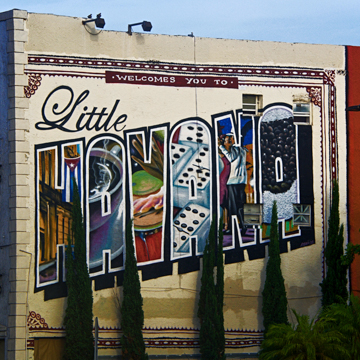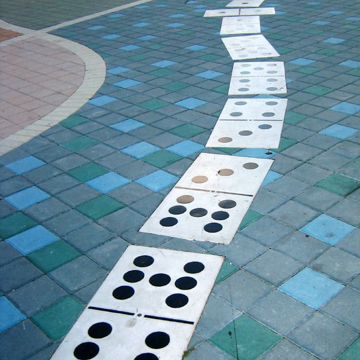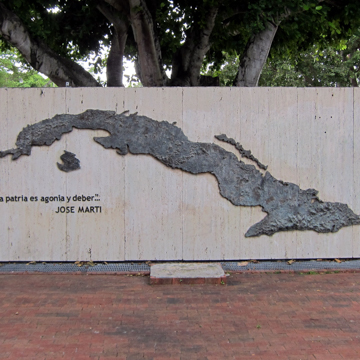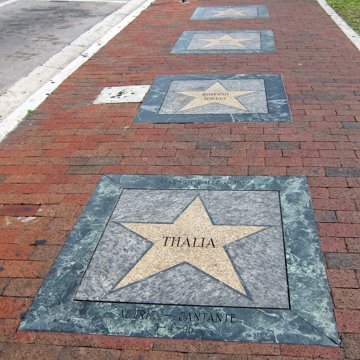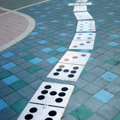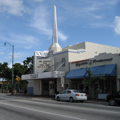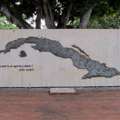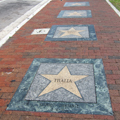Miami’s Little Havana area is bounded east to west by I-95 and 37th Avenue, and north to south by the Miami River and Southwest 8th Street. Seventeenth Street forms the internal boundary between east and west Little Havana. The roughly five-mile neighborhood is just west of the downtown center and is the historical heart of the Cuban American community. This area is dotted with a residential and commercial stock that dates back to the early 1920s. The older area closer to downtown mainly consists of wood-frame cottages, more elaborate masonry block houses styled in a Moorish/Spanish style, and multi-unit apartments buildings no taller than three stories. Further west, the houses become larger in scale and were built after the boom that occurred after World War II.
The main commercial strip of this area is Southwest 8th Street, universally known as Calle Ocho. Today this street hums with Cuban restaurants, tobacco factories, guayabera shops, bakeries, and music clubs. But from the 1920s through the late 1950s the area consisted mainly of “snowbirds” (northerners who wintered in Florida) and Jewish, Lebanese, and Greek immigrants. As the bedroom community of the many merchants who worked and owned the thriving mercantile scene of downtown Miami, this neighborhood had its healthy mix of schools, churches, and synagogues. The Cuban Revolution in 1959 and the lure of the suburbs changed the face of this neighborhood. As the Cuban middle class started fleeing the island in great numbers, the first area of Miami they settled in became known as Little Havana. More fashionable areas such as Coral Gables, Kendall, and Fort Lauderdale were preferred by the older established population, and they moved in great numbers. Over the years the neighborhood changed drastically. Delis were replaced with bodegas, synagogues were turned into churches, and schools taught Spanish as a second language. By the mid-1970s this neighborhood was transformed into a mostly Cuban/Hispanic community.
At the heart of Little Havana, at 8th Street and 15th Avenue, is Domino Park, developed under the leadership of City of Miami planner Jose Casanova. This small urban oasis consists of a cluster of approximately ten domino tables, each under its own tiled roof structure. Older Cuban men and women spend hours playing dominoes, while tourists discretely walk through the park taking pictures. Cuban-born twin artist brothers Ronald and Nelson Curras designed a domino-themed granite walkway and a curving mosaic wall. Next to it is the Art Deco Tower Theater (1926, Robert Law Weed), a once-thriving commercial movie house. It is now managed by Miami Dade College and offers viewings of Spanish-language films and English-language films subtitled in Spanish, and is host to the Gems Film Festival, which is part of the Miami Film Festival.
José Martí Park sits right under the I-95 freeway overpass next to the Miami River. The park was constructed in the 1970s and significantly renovated and expanded in the late 1980s by the firm Wallace Roberts and Todd (WRT). According to WRT, locals wanted a “Cuban-looking” place to play sports, picnic, and swim, to which the firm responded by designing a Spanish Baroque–inspired park. A precast concrete colonnade and parapet, pink-hued pavers, and palms and flowering vines define the space. In 2015, the Chetrit Group announced plans to renovate the park, commissioning landscape architect Raymond Jungles to reinvigorate the space. The 13-acre park is well used today as host to city-sponsored events, from children’s workshops to weekly yoga classes. In 2020, the Miami Office of Capital Improvements initiated a climate-adaptive redesign of the park, featuring shoreline stabilization and an integrated living water management system meant to protect the waterfront from rising waters and to collect incoming rainfall; the redesign also includes a kayak launch, water taxi stop, riverwalk, and new park furniture.
Cuban Memorial Boulevard, along Southwest 13th Avenue extending south from 8th Street to Coral Way (22nd Street), was designated in the 1970s and renovated in 2005. In the median are a series of small sculptures by Tony Lopez designed in 1972 that honor Cuban fighters in the 1961 Bay of Pigs Invasion. Paseo de las Estrellas (Little Havana’s Walk of Fame) on 8th St between 12th and 17th avenues is a sidewalk marked with Hollywood-style stars honoring Cuban and Latin American celebrities. Since 1977, the neighborhood has hosted Viernes Culturales (Cultural Fridays)—a street festival held on the last Friday of every month in celebration of Cuban American culture.
In the past ten years, this once working-class, mostly Cuban neighborhood has become a tourist destination. Double-decker buses drop off hundreds of tourists daily who would normally forgo this area of Miami. They frequent the restaurants and Cuban sandwich shops, buy cigars, artfully designed T-shirts, drink the famous Cuban cortadito, and walk around Domino Park and its environs. As the area continues to thrive, the process of gentrification has slowly crept in. Modest bungalows now sell for $450,000. The main tourist section of Calle Ocho (from 17th to 13th avenues), has seen an uptick in trendy businesses (microbreweries, doughnut shops) that are not particularly Cuban, but more tourist-centric.
In 2015, the National Trust for Historic Preservation added Little Havana to its list of America's 11 Most Endangered Historic Places. A two-and-a-half block area of East Little Havana was designated by the city as the Riverview Historic District, ensuring partial preservation of the neighborhood infrastructure. Outside of the historic district, few of the properties comprising the Little Havana neighborhood would be considered architecturally significant enough for preservation, opening up the possibility of upzoning the whole area. The City of Miami is considering zoning the neighborhood to five stories and 65 units per acre. There are plans to widen the sidewalk to allow for the current heavy pedestrian tourist traffic, and the implementation of street decoration to give the area a more “Cuban and tourist-friendly” atmosphere. In 2019 the National Trust for Historic Preservation partnered with PlusUrbia Design to form a revitalization plan focused on constructing compatible infill buildings and rehabilitating historic structures, improving multi-modal transport, and increasing open and green space. Despite these changes, you can always bet on getting a great Cuban expresso or a plate of Ropa Vieja in Little Havana.
References
Burga, Hector Fernando. “Spatial Politics in Metropolitan Miami: Cuban American Empowerment, Municipal Incorporations, and Cultural Production.” Ph.D. dissertation, University of California, Berkeley, 2013.
Creamer, Colleen. “Calle Ocho's Cuban Accent.” New York Times, April 10, 2016.
Feldman, Marcos, and Violaine. “Back to Little Havana: Controlling Gentrification in the Heart of Cuban Miami.” International Journal of Urban and Regional Research 38, no. 4 (January 2014): 1266-1285.
“José Martí Park Adaptive Redesign.” City of Miami. Accessed March 26, 2021. https://www.miamigov.com/.
“José Martí Riverfront Park [Miami, Fl.].” Landscape Architecture 78, no. 7 (1988): 38-39.
“Little Havana.” National Trust for Historic Preservation. Accessed March 26, 2021. https://savingplaces.org/.
McDill, Virgil. “First Comprehensive Revitalization Plan for Little Havana Is Released.” Press release. National Trust for Historic Preservation, June 11, 2019.
Newman, Janis Cooke. “Time to visit Miami’s Little Havana before change sets in.” SF Gate (San Francisco, CA), June 11, 2016.
Novaes, Marina. “Report of the City of Miami Preservation Officer to the Historic and Environmental Preservation Board on the Potential Designation of Riverview as a Historic District.” City of Miami, Historic and Environmental Preservation Board, February 2015.
Navarro, Mireya. “Within Little Havana, A Change in Accents; Other Hispanic Groups Growing in Miami.” New York Times. April 6, 1997.
Scarpaci, Joseph L. "A Tale of Two Cities: Hialeah's Economic Ties with Havana." American Geographical Society's Focus On Geography 58, no. 2 (June 2015): 49-58.
Shell-Weiss, Melanie. Coming to Miami: A Social History. Sunbelt Studies. Gainesville: University Press of Florida, 2009.
Tamayo, Juan O. “Chronology of the Cuban Revolution.” Miami Herald, November 20, 2008.
Viglucci, Andres. “National Preservation Group: Miami’s Little Havana endangered.” Miami Herald, June 23, 2015.
Whaley, Mirtha, and Amy Paul-Ward. “Keeping Close to Home: The Ritual of Domino Playing Among Older Cuban Immigrants in Miami's ‘Little Havana.’” Generations 35, no. 3 (Fall 2011): 22-27.

